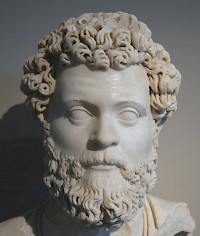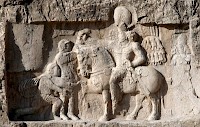Legio I Parthica
Legio I Parthica: one of the Roman legions. Its name indicates that it was recruited to fight against the Parthians.

This army unit and its sisters II Parthica and III Parthica were founded in 197 by the emperor Lucius Septimius Severus, who used them in his war against the Parthian Empire. The expedition was very successful and culminated in the sack of the Parthian capital Ctesiphon. According to the Roman historian Cassius Dio the First and the Third remained in the region, because Severus annexed Mesopotamia (northern Iraq) and converted it into a province.note The Second Parthian Legion was transferred to the Alban mountain near Rome, where it served as the empire's strategic reserve.
It is possible that the full name of the First Parthian Legion was I Parthica Severiana Antoniniana: Severus, who had come to power after a civil war, claimed that he had been adopted by the emperor Marcus Aurelius Antoninus. This fake adoption may have been commemorated in the name of the new legion.
I Parthica was stationed in a fortress called Singara (modern Balat Sinjar), where it stayed for centuries, defending the empire against the Parthians and - after the fall of their empire - the Sasanian Persians. The province Mesopotamia was not a common province, because its governors were prefects from the equestrian order, not senatorial governors. Accordingly, the commander of I Parthica was not a senator but a Roman knight.
The First must have taken part in the expeditions of third century, like the one led by Severus' son Caracalla (217) and the war waged by Severus Alexander against the new, Sasanian Persian empire. The Sasanians had invaded the Roman empire in 230 and had installed an emperor in Emessa, but Severus Alexander was able to restore order and invade Iraq. In 244, the Romans again invaded Iraq, but their emperor Gordian III died and was succeeded by Philippus Arabs, who owed his throne to the Sasanian king Shapur I.

Even worse was to come In 256 Shapur captured Satala (the fortress of XV Apollinaris), and two years later he sacked Trapezus. When the Roman emperor Valerian tried to restore order and invaded Iraq, he was defeated and captured. These Roman defeats are commemorated on several Sasanian monuments. Captive Roman soldiers were ordered to build a bridge at modern Shushtar.
However, under the emperors Odaenathus of Palmyra (r.261-267) and Diocletian (r.284-305), the Romans restored their fortunes and in 298, a peace treaty was concluded in which the Persians had to give up territories in northern Mesopotamia. The First Parthian Legion must have played a role during these campaigns, but we have almost no information about them.
It was not uncommon that subunits of a legion were sent to other parts of the empire. From inscriptions, we know that soldiers of the First Parthian legion served in Lycia and Cyrenaica. The soldier who buried his son in Cilicia was probably not on a foreign mission, because Cilicia is close to Mesopotamia. (It is possible that this soldier belonged to III Parthica.)
In 360, the First Parthian legion was still at Singara, because it is mentioned as one of the units that tried to defend the city against a Persian attack. Unfortunately, they failed, and I Parthica was transferred to Constantina, where it is mentioned in the early fifth century.
Related
- C. Wolff, "Legio I Parthica", in: Yann Le Bohec, Les légions de Rome sous le Haut-Empire (2000 Lyon) 247-249
- article by Emil Ritterling.